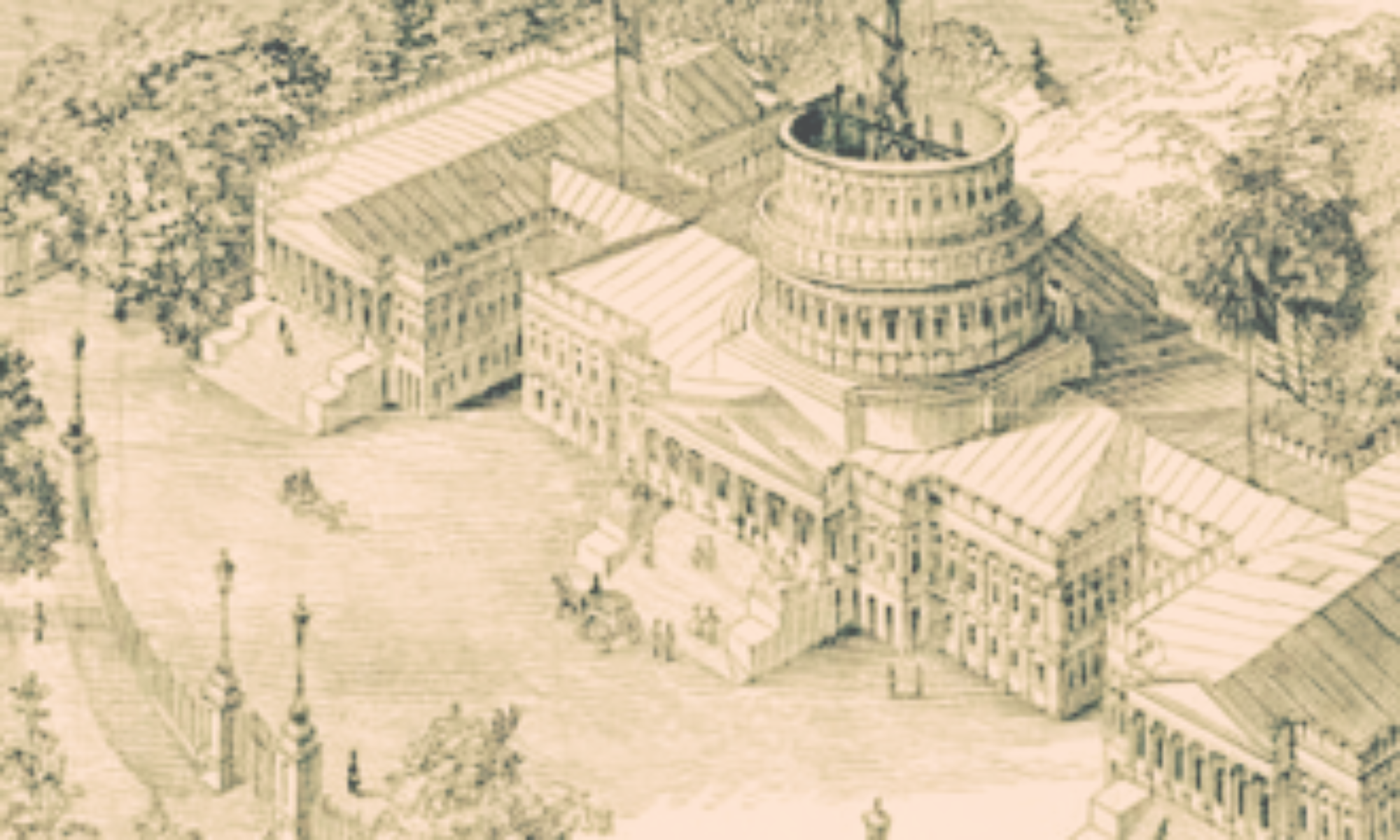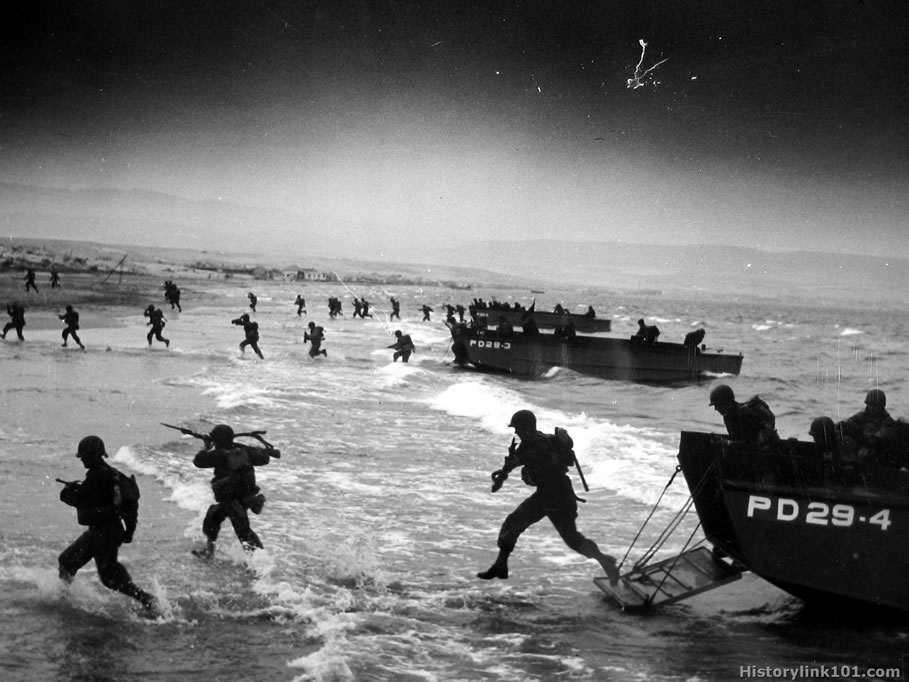Anniversaries of epic battles in defense of our nation don’t always fit neatly into America’s summer schedule of three-day weekends. But June holds two dates – two days apart – that epitomized the sacrifice and courage of our soldiers and sailors, and decisively changed the course of WWII.
They deserve mention here.
As I noted in my Memorial Day post, sixty four years later, the conventional wisdom of history has fixed WWII as an inevitable victory. With America’s enormous industrial potential, plentiful energy supplies and reserves of fighting age young men, the war was only a function of how much overwhelming power would be required to beat the Germans/Italians and Japanese.
Movies such as “Saving Private Ryan” point to the brutality and violence of war, but as we watch these scenes, we are all Monday morning quarterbacks; knowing how history played out, how the sacrifices cumulatively led to victory.
But the people fighting those battles six decades ago didn’t know that. For them, how the war would end was very much an open question, and their own participation was a tool of decision.
How they acted, what they did mattered.
Midway
Long time readers of this journal will know of my personal interest in this battle, because the odds were so long and the very decisive results were based ultimately on the actions of a few, acting on their own.
The year is 1942.
The truly colossal military infrastructure and technologically advanced combat systems and experienced service personnel assembled and deployed by the United States to win WWII were not immediately available in the opening days after Pearl Harbor. The Admirals and Generals who commanded American forces knew that they would have to make do with what they had until that time.
And the American situation in the Pacific was precarious The December ’41 attack on Pearl Harbor had wrecked the American battle line and Army Air Forces. The Japanese task force that had attacked Pearl Harbor had since sailed across the Pacific from Hawaii to Ceylon, sinking allied ships along the way and attacking land installations, all without losing a single ship.
In the intervening period, American forces on Wake Island and then the Philippines had surrendered. Current day Indonesia and Indo-China were occupied by the Japanese and Australia was dangerously exposed.
For the Japanese, the success of the Pearl Harbor attack and the operations since had exceeded their most optimistic expectations. Recognizing American industrial potential, the Japanese high command focused on a final, decisive battle to bring the remaining elements of the U.S. fleet to battle and destruction, with the hopes for a negotiated peace with the US that would leave Japan as the dominant power in the Pacific and Asia. The Japanese choose Midway Island, at the very top of the Hawaiian Islands chain, and within flying distance of Pearl Harbor, as the target.
To take Midway and bring the US fleet to battle, Japanese put together the largest concentration of naval power ever assembled in the Pacific until that time. More than 150 ships with four large aircraft carriers and 188 planes for the attack on Midway.
Chester Nimitz, Commander in Chief of the American Pacific Fleet was not oblivious to the Japanese plans. US intelligence had broken the Japanese code, and Nimitz knew the broad outlines of the Japanese operation. To defend against the Japanese onslaught, Nimitz would have 3 carriers, 8 cruisers, 15 destroyers and 12 submarines; 38 ships in total to take on the huge Japanese fleet.
What happened next represented one of the finest moments in US military history, where intelligence, persistence and luck were elements, which when combined with courage and individual initiative, changed the course of the war in the Pacific.
On June 4th, the Japanese naval air forces bombed Midway Island. Having located the Japanese carriers from search aircraft, both the American fleet and Midway based bombers launched attacks on the Japanese.
The first attacks are made by American torpedo attacks that are quickly and tragically defeated. But the torpedo plane attacks from the US carriers and Midway had caused significant disruption and confusion to the Japanese task force commanded by Admiral Nagumo.
However, now, armed with his own intelligence of the forces arrayed against him, and with knowledge of American carriers in the region, Nagumo re-grouped and readied his own massive airstrike on the American fleet; the determinative battle that the Japanese had planned for.
At 1020am on June 4th, the Japanese fleet was on the verge of regaining the initiative, its flight decks full of the most sophisticated and best trained naval air forces in the world, concentrated for a blow against the American carrier task forces. Nagumo, who had led the Japanese attack on Pearl Harbor six months before, stood on the precipice of a victory as great as Nelson at Trafalgar.
Ten minutes later, the battle – and the war – had changed decisively.
Dive bombers from the American carriers, flying at high level, had found the Japanese fleet as its planes prepared to launch. With Japanese fighters now at sea level after attacking American torpedo planes and with the fleet preoccupied with launch operations, the American dive bombers were free to attack virtually unimpeded.
Sometime after 1020am, Lt. Wilmer Earl Gallaher, 35, hit the Japanese carrier Kaga with the first of five, 500 pound bombs that took the carrier out of operation and led to its scuttling later that night.
At the same time, Lt Cmdr Richard Halsey Best, 32, was also preparing to make a run on the Kaga. Seeing the initial success of the American raid, Best made the snap decision to move and attack a different target. Best dove on the flagship carrier, Akagi.
Best’s bomb was the only weapon to actually hit the carrier, the single 1,000 pound bomb was all that was necessary to put Akagi out of action, and with the raging fires it started, led to the scuttling of the Akagi later that night. At the same time, pilots from the US carrier Yorktown hit the Japanese carrier Soryu with three bombs that put her out of action. Soryu sank later that night as well.
The fourth Japanese carrier, Hiryu, escaped the initial US attack. However, American aircraft spotted the Hiryu in the afternoon and US forces launched an attack.
In this raid, Best and Gallaher were joined by Lt. DeWitt Wood Shumway, 33. Shumway, ordered to attack a Japanese battleship, but saw that the initial American attack on Hiryu was unsuccessful. He changed course for the carrier, dove, and delivered the first of four hits that doomed the Hiryu. Best too, bombed Hiryu successfully.
From an initial position of overwhelming superiority, the Japanese now faced an entirely different strategic equation. With Nagumo’s carrier force destroyed, the entire invasion force and the main body of the fleet was vulnerable to air attack by the Americans. Based on the new strategic facts, the Japanese called off the invasion and ordered the Japanese fleet to retreat.
The Japanese never went on the offensive again during the Pacific war.
Those three men, Best, Gallaher and Shumway, were responsible for 4 of the 13 hits on the Japanese carriers on June 4th. Best himself sank Akagi alone, and contributed to the sinking of Hiryu, easily making him the most consequential pilot of the battle, and one of the most significant pilots of the war. Their courage and initiative turned the tide in the Pacific war.
Rarely in history’s grand sweep is such change based on the actions of so few.
Normandy:
Like a well told tale, the Anglo-American invasion of France has become lore. The ramps from transports rolling down, troops storming the beaches in Normandy, establishing a beachfront, and beginning the final phase of the war that would end 11 months later. 160,000 US and allied troops were involved in Operation Overlord, the code name for the operation. It was and remains the largest amphibious operation in history.1
And the stories of heroism and sacrifice are known as well. The Americans who landed on Omaha beach faced the veteran German 352nd Infantry Division, one of the best trained on the beaches, in one of the most heavily fortified areas.2 It was one of the toughest fights in American military history.
But many of the details of that day are less well known. The US 1st and 29th Infantry Divisions and the 2nd and 5th Ranger Battalions were committed to taking Omaha Beach. The 29th was a “green” division that had not seen combat.
Through acts of commission and omission, the majority of the landing craft missed their assigned sectors. Casualties among the first wave were nothing short of catastrophic, where surviving American troops were leaderless isolated and traumatized by the violence surrounding them.
Commanders considered abandoning Omaha, but as the second wave of landings came in, small units of infantry, often forming as ad hoc groups, eventually infiltrated the coastal defenses and created an isolated foothold that was expanded and consolidated in the coming days.
It was at that time of decision that Lt Walter Taylor, Company B (or Baker), 116th Infantry, of the 29th Division, came ashore in the second wave. Taylor, with others of courage and initiative, saved the landing from disaster.
Landing after the first wave, Taylor didn’t know that his commanding officers were already dead. Taylor led his section crawling across the beach and over the sea wall. He continued to lead his section by trail straight up the bluff and into Vierville, where he engaged the Germans in a two-hour fire fight and won without losing a man.
Meeting up with other elements of Baker Company, Taylor realized that he is in command. The sergeant did a head count – there are only 28 men out of the original 240.
Taylor proceeds to lead the 28 men inland against an imposing German fortification with rock walls and artillery proof tunnels. Taylor engages the Germans there and continues the fight throughout the day, and continues to lead a force mixed from his company and several Rangers, trying to reach goals outlined in the Overlord plan for Day 1. By nightfall, Taylor and his men camp near the village of Louvieres. A runner finds them with a message to fall back to meet up with the remnants of the battalion, closer to the sea.
Taylor had led his men to a place a half a mile ahead of the rest of entire United States Army in Europe.
A soldier under his command paid Taylor this tribute. “We saw no sign of fear in him. Watching him made men of us. Marching or fighting, he was leading. We followed him because there was nothing else to do.”
Roughly 2,000 Americans died on Omaha Beach on June 6, 1944. They are joined by 4,600 other Americans who were killed or wounded that day. The high ground, and the day, was carried by a handful of men, like Taylor, who performed beyond the confines of common understanding.
Taylor himself passed on April 17, 2003, a retiree of the Baltimore Police Department.
Time and again, when the odds have been daunting, in the face of a superior enemy, individual American courage, determination and resourcefulness has been the common element in uncommon valor; valor that has decided the course of history.
Of the 16 million Americans in uniform during WWII, there are only 2.5 million still living. The solders of WWII are passing at the rate of 1,000 per week.
So take a moment, outside of our summer weekends of remembrance, and thank the people who helped secure the world we live in today. They fought the good fight and through their efforts, enabled the end of one insidious tyranny that we assume with simple certainty today.
1. Wikipedia – Operation Overlord
2. Ibid

